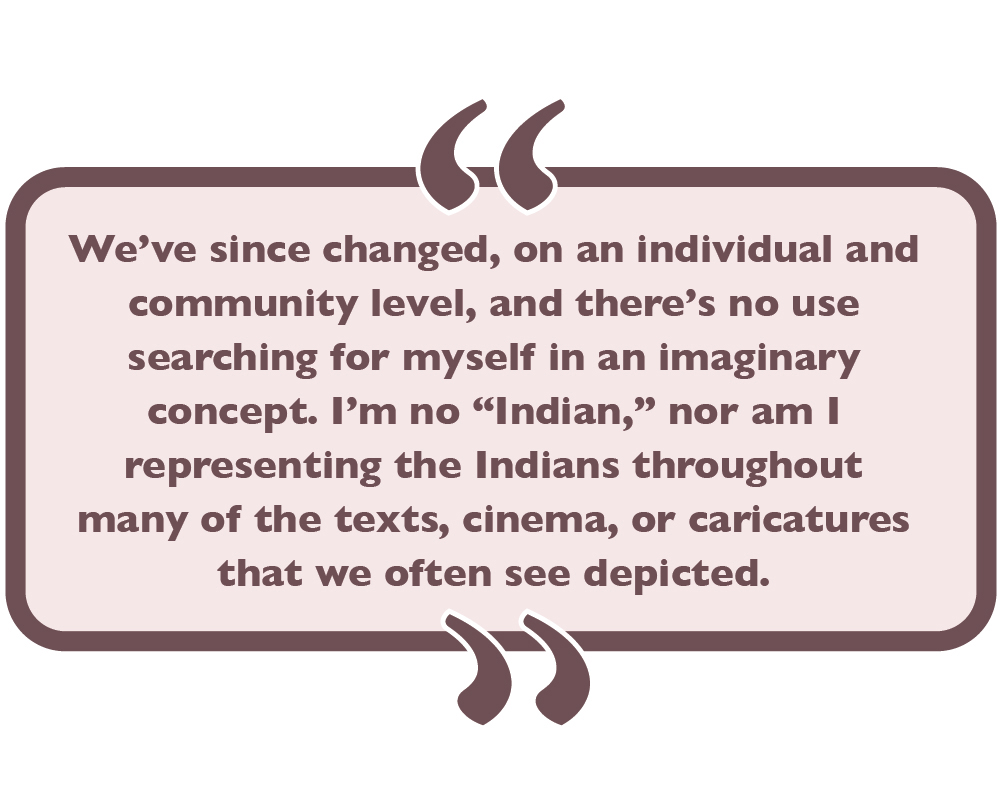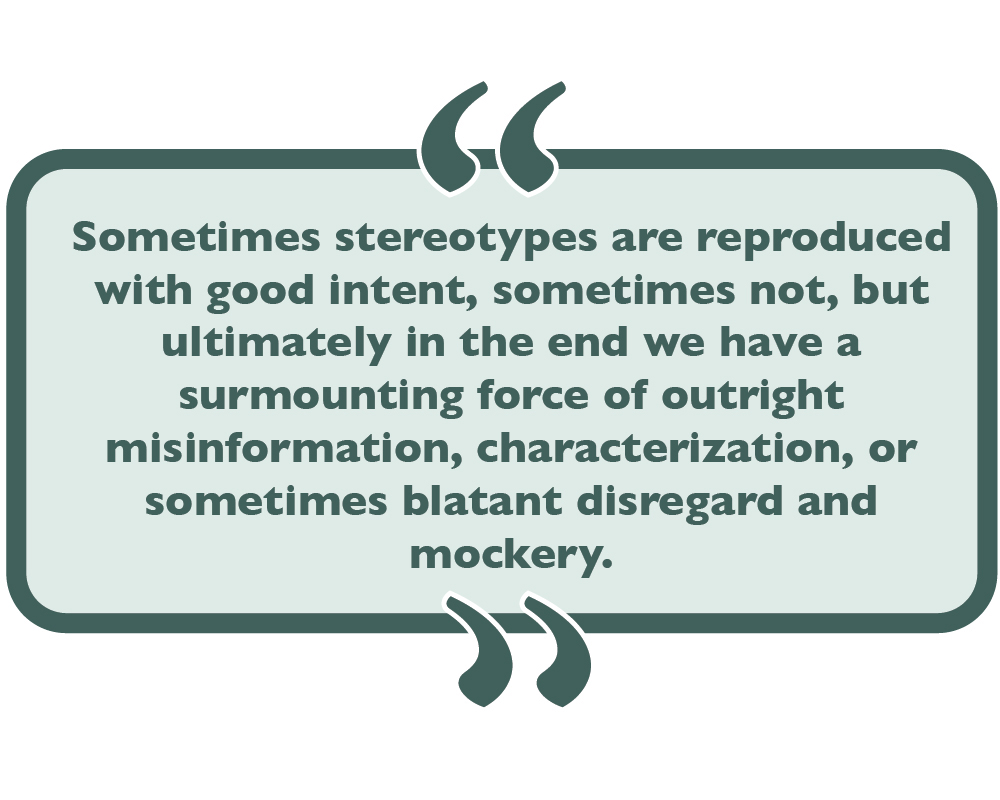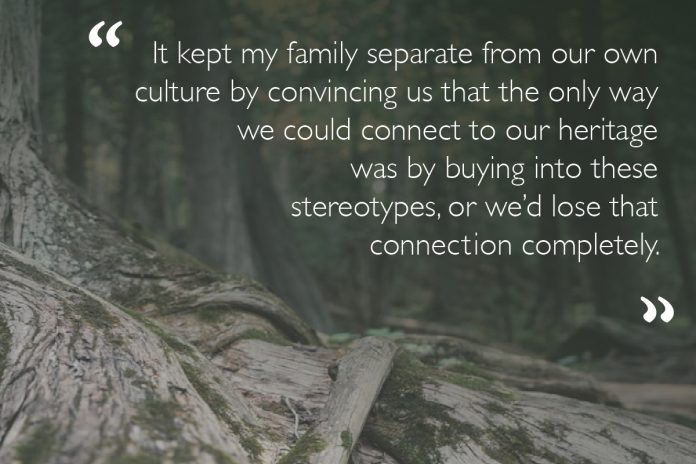The search for what “Indianness” really means
I was 12 years old when the chief of our tribe, Chief Hidden Wolf, came from our Peepeekisis reserve to cleanse and welcome my grandparents’ totem pole with sacred ceremony. We sat in a circle and took turns smoking the pipe (of which I was not allowed to participate), and afterward he showed me how to replicate the shape of a wolf paw with my knuckles in the still-wet cement that would soon harden to hold the pole upright. I was in awe of his reverence, and he shed an awareness on my life, and the relationships I fostered, with new meaning.
With this knowledge has come the gratitude of walking the path of my ancestors, from animism to intentions, but acknowledgment of my roots has also revealed the burden of the pain from our pasts — we are still connected to our ancestors, but that connection has also been strained. We can relate to earth, animals, and to each other with openness and respect, but we cannot speak the words for our kinship with our native tongue. Growing up, I held this idea of what it meant to be Indigenous from the hodgepodge of information my family was still able to pass on and from the depictions of stereotypes that I had witnessed in the media. This has been repeatedly challenged by literature I’ve since studied in my adulthood and some of my most recent experiences as I discovered that my romantic notion of Indigeneity was just smoke and mirrors — a projection of what I wanted rather than what was actually occurring within my own community.
I have gained perspective from Indigenous voices, and from this has stemmed an awareness that there are so many things about my own heritage that I have not understood the reality of. Relating to these perspectives has been a journey, and hearing Indigenous stories has helped me to break down the stereotypes that I had been spoon-fed from my youth. It’s made me question my attachment to my culture until I’m left wondering if I’m just another white Indian girl, almost to the point where I want to do as Drew Hayden Taylor says in his play, The Baby Blues, and “check the authentic Native totem-pole for a ‘Made In Korea’ label.” And if I didn’t know my grandparents better, maybe I would have.

To better understand the dichotomy between the life of North American First Nations and the lifestyle that my own family had been conditioned to believe, we need look no further than the disconnect between the reality of living as Indigenous and the perceived reality we are fed through stereotypes and bias. The colonization of Indigenous people had successfully removed any connection with the traditions and cultural ties my family had, even though multiple of my aunties, uncles, and cousins were being raised on our reserve in Saskatchewan a day’s drive away from where the rest of us resided in the Fraser Valley. We may as well have been in separate countries for the differences in upbringing.
Daniel Francis summarizes this issue well, stating the following in his book The Imaginary Indian: “Few children in Canada had any direct knowledge of Native people, who were pretty much confined to their reserves at the margins of society. Instead, White kids were exposed to images of the Indian created by various White writers and educators.”
With many Indigenous communities living completely separated on reservations, away from the constructed society of colonized Canada, European settler descendants have no real exposure to the culture and the plight that Indigenous people are actually living with. White people were (and still are) attached to a romanticized representation of what it means to be Indigenous that had been cultivated to placate the imaginations of children as an outlet for their loss of freedom as they aged and matured out of childhood — an ideal epitomized by multiple creative sources often depicting Indigenous as free and unrestrained.
It’s why the game of cowboys and Indians was created; it’s why so many people romanticize the perceived “freedom” of being born Indigenous, because we have this idea that was solely created as an escape from a society that seemed to support anything but being free and independent. To highlight this point we can reference another quote from Francis, also from The Imaginary Indian, when he states that “People began to believe that the Indian retained qualities the ‘modern man’ had lost. If civilization was artificial, frenetic, and soulless, the Indian seemed to live a more authentic existence, closer to nature and basic human values…” Such escapism offered up being Indian as being independent, roaming wherever they pleased with wild abandon. Innate Indigeneity, represented in the sacredness of the customs and traits that have been passed down to each unique tribe, is competing with the European projection of what it means to be “Indian.” And with such a lack of Indigenous representation in the media and literature we can start to understand the uphill climb necessary for Indigenous storytellers to break down this idealized and stereotypical depiction of Native American culture and identity.
We can see that white European descendants looking for an “authentic” Indian are really just looking for a vanished Indian, for their own comfort, and whether that’s through play acting as Indian or outright continuing colonizing practices, it’s still keeping the Indigenous reality separate from the everyday North American reality. It kept my family separate from our own culture by convincing us that the only way we could connect to our heritage was by buying into stereotypes, or we’d lose that connection completely.
Outside my personal experience, this issue is presented hilariously in The Baby Blues, written by Ojibway author Taylor. Taylor depicts a white anthropology student named Summer visiting a reservation, who can’t quite believe everything she had learned and imagined about Indianness is fake. (Although, to her credit, she at least could speak Cree and Mohawk languages.) We bear witness to her stubborn disbelief through her exaggeratedly outrageous dialogue: “SUMMER: … Oh, how beautiful, simply so beautiful. Just smell that wood smoke, the bacon frying — what a pity I don’t eat meat. Oh, listen to the children of nature playing, being one with the lake … Here I am, surrounded by trees, flowers, grass, squirrels and Native People. Tree to tree, First Nations, Aboriginal people in their natural environment.”
Taylor addresses this character in the play the same way he addresses many of the issues mentioned in his works — with humour. As a coping mechanism, it’s a powerful tool; using humour to address the dark underside of detachment from Indigenous culture is a weapon in disarming the audience. What else can you do but laugh when we read about white people pretending to be Indigenous throughout such stories and plays?
Sometimes stereotypes are reproduced with good intent, sometimes not, but ultimately in the end we have a surmounting force of outright misinformation, characterization, or sometimes blatant disregard and mockery. This feeds back into the stereotype of what it means to be Indigenous, feeding into the dehumanization of an entire race of people. Here we see Summer “playing” the Indian, and regardless of extensive research and perhaps the best of intentions, she still manages to fall flat.
For myself, maybe the real issue was searching for my “Indianness” in the first place, and, like Summer, naively finding my place in an empty stereotype — despite the fact that I’m actually of Indigenous descent. She is an exaggerated representation of all the white people who try to “go Native,” even as she repeatedly gets ridiculed by the Native men, similar to how I tried to exaggerate my own connection with my Indigenous heritage because I didn’t have any other way to relate to my own ancestry.

The Indigenous men end up exploiting her naiveté to their advantage, such as the character Skunk in this excerpt:
“SUMMER: Excuse me but, if you don’t mind me asking, where are you going with the towel. A sweatlodge maybe?
SKUNK: A swim.
SUMMER: Oh.
SUMMER looks disappointed and SKUNK catches this. His attitude changes.
SKUNK: …Ah yes, … I’m going for my … morning purification … cleansing swim, in the lake … Mother Earth’s lake … the tears of Mother Earth.
SUMMER: Really?!
SKUNK: Yes, I do it every morning … to greet our brother the sun. […] If you want, you can join me. If you’re into that I mean.
SUMMER: Oh yes, yes. I’d be honoured. Is it permitted?
SKUNK: I don’t see why not but I must warn you, in order to reveal yourself to the world, you have to be … completely naked.”
At least I’ve never been duped into a naked swim on my search for the Indians of my own childhood. This I can be grateful for.
The very first time I read the lines of Marilyn Dumont’s poem, Not Just A Platform For My Dance, I was struck by her ability to clearly outline where her boundaries are in relation to her own physical body and her connection to the land, and how she leaves the reader with no option but to respect them. She begins abruptly, sharply removing any preconceived notions we may have by emphasizing her points with the intentional use of spacing in her writing. When she states “this land is not / just a place to set my house my car my fence,” Dumont is clarifying that the land is not an object and is not to be claimed, just as her own body has its own sovereignty. Both ideas are foreign concepts for a young woman, especially one with Indigenous heritage.
My own great grandmother was a residential school survivor and was tortured using electric shock “therapy” until any aspects of connection with herself, the land, and her heritage were successfully erased. My family subsequently had little connection with our Indigeneity, and as a consequence, with ourselves and with each other.
When Dumont says “this land is my tongue my eyes my mouth,” she is blurring the lines between who she is and the earth she is residing on. It’s a belief that inherently opposes the way we, in our North American capitalistic society, view land as an object, a means of material gain, and as a possession to be claimed by whichever individual can pay the most. Perhaps this is where the irony of Dumont’s lines really stands out as she connects herself to the earth because we’ve consistently viewed Indigenous women in much the same way: as things to be objectified, possessed, and used. And not much of that narrative has changed, even as we progress further as a society. Even as we begin to acknowledge some of the pain that has been brought onto them, we still have to contend with the harsh injustices that are faced by women of colour.
Dumont ends her poem by honouring the land — and herself — as not only a vessel of mindfulness and creative expression but also as a source of healing, writing that all the aspects that make up the land she resides on “are my prayer they are my medicine / and they become my song.” This isn’t romanticizing independence and freedom or a glamorized connection to nature. This is removing the separation of us from the land, and subsequently from others, entirely. Dumont sets the tone for hope that by understanding our existence within the world, and within ourselves, we too can begin to heal.
It’s on that note that I will end this narrative, for I don’t agree with holding myself personally responsible for maintaining the cultures and traditions as they were historically, before colonialization. We’ve since changed, on an individual and community level, and there’s no use searching for myself in an imaginary concept. I’m no “Indian,” nor am I representing the Indians throughout many of the texts, cinema, or caricatures that we often see depicted. I’m not even the stereotype that I sought in my childhood. Much of my heritage was lost, and many of my family are doing the utmost to fight against the version of the “Indian” that we were forced to portray.
I see myself seeking sovereignty in Dumont’s poems, and I relate with Taylor when he describes himself as a “pretty white boy,” for on the outside my family presents as a prosocial white family: fairly well off, some of us educated and employed, most of us in fulfilling partnerships, most of us happy and healthy. Unfortunately, the trauma of what we have sustained as Indigenous people seeps through our dark underside, themes that are echoed across blended heritage families and card-carrying First Nations living on reserves alike: suicide and mental health struggles, addiction issues, cousins missing and murdered. I live within both realities, and just like Taylor, I can look at my history from both sides to hopefully create a new storyline for the generations to come.


